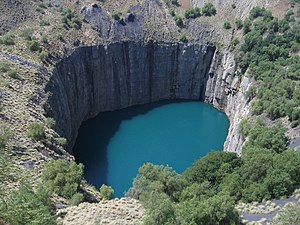The big hole
| The big hole | ||
|---|---|---|

|
||
| The big hole | ||
| Geographical location | in Kimberley | |
| Drain | - | |
| Islands | - | |
| Places on the shore | Kimberley | |
| Data | ||
| Coordinates | 28 ° 44 ′ 19 ″ S , 24 ° 45 ′ 31 ″ E | |
|
|
||
| surface | 17 ha | |
| length | 463 m | |
| scope | 1.6 km | |
| Maximum depth | 40 m | |

|
||
| Official site plan of the claims from "Colesberg Kopje" (August 1874) | ||
Big Hole ( German The big hole ) of Kimberley in South Africa is the open pit of the former Kimberley Mine, from to 1914 diamonds were promoted.
The hole is often referred to as "the largest hole ever dug by human hands". The Big Hole competes for this record status with Jagersfontein , an open pit 110 kilometers southwest of Bloemfontein . The Big Hole is a little deeper, but Jagersfontein has a larger volume. However, the term “largest hole ever dug by human hands” is misleading; it only applies if you are limited to rather simple tools, dynamite and hollowing out with steep walls.
geology
The diamond-bearing rock is a breccia-like sub-volcanic material that carries fragments of peridotites , garnet peridodites , garnet pyroxenites and eclogites from the lower crust and the upper mantle. This type of rock is called kimberlite after the well-known South African place . These are serpentinized and carbonated mica peridotites . The main minerals include olivine , phlogopite , diopside , serpentine and calcite . The diamonds are included as single pieces.
Data
The Big Hole has an area of 17 hectares. It has a circumference of 1.6 km at the surface and a diameter of 460 m. From 1871 until the end of mining in 1914, 22.5 million tons of rock were excavated. The amount of diamonds unearthed in the same period was 2,722 kg or 14.5 million carats.
When the mining operations were stopped, the open pit was 240 m deep. Today it is filled with water at the bottom; the water level is now 175 meters below the surface of the wider area. Since 25 meters of rubble has accumulated on the bottom after the mining operations were closed, the remaining water depth is 40 meters. The underground mining reached a depth of 1097 m.
The Big Hole is located in the middle of the city and is worth seeing on the one hand because of its huge dimensions and on the other hand because of the mining and open-air museum on the edge of the Big Hole . A historic tram also runs between the town hall and the museum. Today the original shape of the volcanic chimney is clearly visible as a hollow from the diamond extraction.
history
After the first diamond ("Eureka", 21.25 carats) had been found near the Orange River and other diamonds in the open field in alluvial sediments in 1866 , the dealer John O'Reilly had Dr. Anthestone at Rhodes University in Grahamstown analyzing samples that he identified as diamonds. As early as 1870, around 50,000 people were working in the diamond fields around Kimberley. The brothers Johannes Nicolaas and Diederik Arnoldus de Beer bought farmland in South Africa in 1871, but could not withstand the pressure of the growing diamond market and sold the mines. Even so, a mine took its name. In July 1871, Fleetwood Rawstorne discovered a handful of diamonds in Colesberg Kopje , later the Big Hole.
In 1888 the organization " De Beers Consolidated Diamond Mines" was founded by Cecil John Rhodes and Charles Rudd . On August 14, 1914, The Big Hole was closed for lack of profitability.
tourism
From a steel frame you can look into the abyss. There are tours around the Big Hole and a large museum that tells the history of the Big Hole.
literature
- Ernst Klimm, Karl-Günther Schneider, Bernd Wiese: Southern Africa. Vol. I. Republic of South Africa-Swaziland-Lesotho . Knowledge Buchgesellschaft, Darmstadt 1980, ISBN 3-534-04132-1
- Wolfhard Wimmenauer : Petrography of igneous and metamorphic rocks . Enke, Stuttgart 1985, ISBN 3-432-94671-6
Web links
- Big Hole: The Kimberley Mine - Kimberley Mine Museum (English)
- Kimberley - Mine Museum (English)
Individual evidence
- ↑ Jagersfontein Mine. Retrieved August 5, 2010 .
